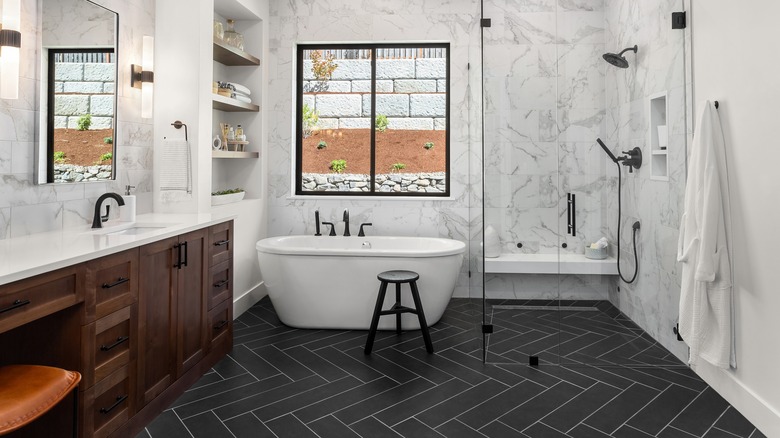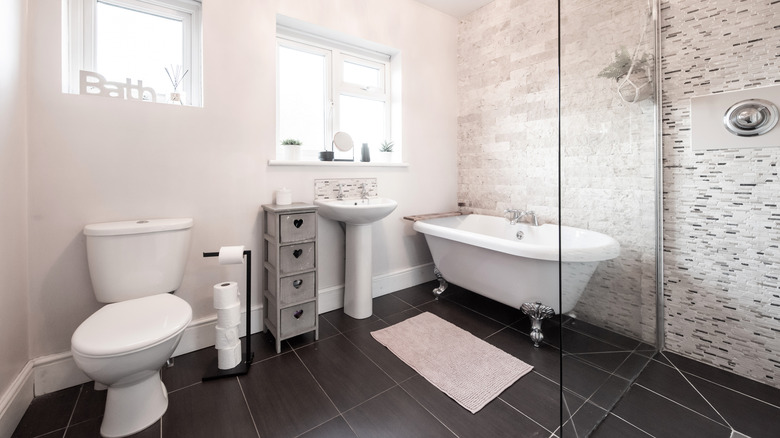No Demo Reno's Jenn Todryk Says This Shower Floor Reno Is Worth The Expense
Bathroom renovations aren't typically the most affordable endeavor. With national averages hovering at $12,054 per bathroom remodel (per data from Angi) — it's high ticket expenses like rearranging your bathroom layout and investing in high-end materials that drive up the price tag of this already costly project. But sometimes, bathroom renovations are necessary for functional and aesthetic upgrades and it's helpful to know where you should splurge, and which expenses to skip. As HGTV's Jenn Todryk, star of "No Demo Reno," knows, one thing that's always worth spending extra money on is safety. And on Season 3, Episode 7 of "No Demo Reno," she shares an upgrade that helps homeowners create a beautiful and safer bathroom: tiles with lots of grout lines.
Todryk's client complained that the existing floor was slippery when wet, posing a safety hazard for her daughter and grandkids. To solve the problem, the designer opted for smaller floor tiles with lots of grout lines to replace the existing shiny oversized tiles. She explained that more grout lines can bump up a bathroom remodel total by up to $1 extra for every square foot of tiling. "You get that natural grippage" Todryk explains, adding, "More grout lines typically means more money. Grout adds anywhere from 50 cents to a dollar more per square foot. But for Brenda and her grandkids' safety, it's obviously worth it," (per Realtor.com). Below we break down Todryk's choice, show why it's a safety-savvy and design-forward selection, and provide alternatives to help you plan a safe and stylish space while cutting the cost of your bathroom remodel.
Are more grout lines really worth the expense?
Jenn Todryk knows how to tackle a renovation for function and style on HGTV's "No Demo Reno," but, is her bathroom tile upgrade really worth the added expense? Although using smaller tiles with more grout lines may only cost 50 cents to $1 extra on a square foot, this expense can add up depending on the size of your bathroom and your tile design. For example, while a small apartment bathroom may average 40 square feet in size, it's not uncommon for new-build master bathrooms to hit 210 square feet in size. Luckily, this means that if Todryk's estimation is right, smaller tiles with more grout lines may only cost you $40 to $210 more. And, Todryk's advice on small tiles is correct — because of the textural variety, more grout lines do create a surface with extra grip for added safety.
But, the total cost to tile your bathroom may rise if you choose a herringbone tile as Todryk did. Because of the intricate layout and increased labor required for this pattern, herringbone tile is typically more expensive than a traditional grid layout. Also, because you won't be laying the tiles square with the walls but diagonal to create the pattern, there is likely to be more waste, which will also increase the final cost. But, it's also useful to note that herringbone floors might actually improve your home's value. The final verdict: Todryk's upgrade may be a relatively inexpensive safety measure, but the total cost depends on your bathroom size, and what tile and installation pattern you select.
How to get safe and stylish bathroom floors for less
If safety and avoiding slips and falls is a big concern, you'd be right to stay away from large high-gloss tiles, both in your bathroom and in any high-traffic areas that are prone to wet surfaces like your entryway, patio, or kitchen. But to keep costs down and avoid the increased labor associated with installing tiles with extra grout lines, you might want to consider moderately-sized matte tiles for your bathroom or shower, which require fewer grout lines, and therefore less labor as well. Other options that boast better grip include slate effect tiles and terracotta tiles which have texturing that creates a natural anti-skid effect.
Thankfully, there are many stylish non-slip shower tiles that won't break the bank. Most modern bathroom tiles are designed with non-slip properties so before you buy, it's a good idea to ask your tile retailer to show you these varieties. Also, most modern tiles come with a rating that lets you know their slip resistance. The "R" or Ramp Test rating runs from R9 to R13, with R13 being the most slip-resistant and most commonly used around pools and outdoor areas that are constantly wet. Retailers state that R9 tiles are suitable for bathrooms, but recommend using a bathroom mat to dry feet on. If your renovation involves a separate shower area, R9 tiles may be perfect, but for a wet room design, you may want to opt for R10 (or higher) tiles to ensure safety and prevent slips.


